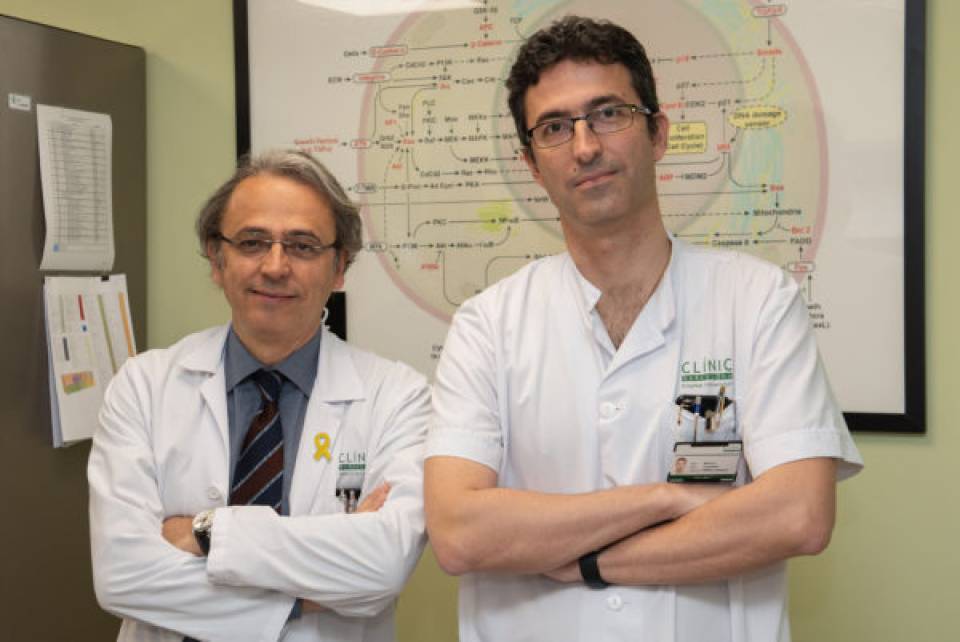Among the authors of the text, which has been presented today at the annual conference that the EASL celebrates this week in Paris, are Dr. Josep Maria Llovet, ICREA Professor at IDIBAPS where he heads the group Translational research in hepatic oncology and Director of Liver Cancer Program at the Icahn School of Medicine at Mount Sinai in New York, and Dr. Alejandro Forner, both from the Hepatic Oncology Unit at Hospital Clínic-IDIBAPS and researchers from the CIBEREHD.
Hepatocellular carcinoma (HCC) is the most common type of liver cancer, the third leading cause of death from cancer worldwide and has an incidence of 800,000 new cases per year. In the last 10 years, the treatment of hepatocellular carcinoma has evolved considerably. At present, patients with this type of tumor can benefit from different treatment options that increase their survival, regardless of the stage of the disease at the time of diagnosis.
For this reason the EASL has revised the previous guide, published in 2012, to adapt it to new treatments and scientific advances produced in recent years. In the elaboration of the new version, 8 panelists have participated: four hepatologists - Drs. Llovet and Forner included-, a surgeon, an oncologist, a pathologist and an interventional radiologist.
The text, the result of consensus among leading European experts in the field, offers recommendations to address different aspects of hepatocellular carcinoma such as the implementation of screening programs, diagnosis, classification, surgery, molecular treatments, design of clinical trials and evaluation of patient’s response. The therapeutic algorithm recommended by the new guide continues to be the classification system established by the Hepatic Oncology Unit (known as Barcelona Clinic Liver Cancer, BCLC), an internationally recognized multidisciplinary team which involves professionals from the Hospital Clínic and IDIBAPS. As a novelty, the guide incorporates the new molecular therapies that have been proven to be effective recently, 10 years after the approval of sorafenib (regorafenib, lenvaitinb and cabozantinib).
In the new guide, there is a classification of the degree of recommendation of all available treatments based on their level of evidence. "All new drugs appear in this classification, both those that have given positive and negative results, as well as other treatments such as liver transplantation," explains Alejandro Forner.
"The previous version of the guide prepared jointly by EASL and the European Organization for Research and Treatment of Cancer (EORTC), which I also co-authored, received more than 2,500 citations, which indicates its relevance and acceptance among professionals involved in treatment, research and education in liver cancer," says Josep M. Llovet.
The authors suggest that, in order to face the growing incidence of the disease, several actions must be carried out in three different areas: implementing public health policies to prevent, detect and treat chronic liver disease; carry out appropriate cancer surveillance programs to detect hepatocellular carcinoma in early stages amenable to curative treatment; and, in clinical trials, link molecular subclasses of the tumor with the response and outcome of patients, to integrate the biology of the tumor with precision medicine.
Reference:
EASL Clinical Practice Guidelines: Management of hepatocellular carcinoma European Association for the Study of the Liver: Peter R. Galle, Alejandro Forner, Josep M. Llovet, Vincenzo Mazzaferro, Fabio Piscaglia, Jean-Luc Raoul, Peter Schirmacher, Valérie Vilgrain J. Hepatol. 2018. DOI: https://doi.org/10.1016/j.jhep.2018.03.019

